Tracey Warr's Blog, page 3
November 25, 2024
Medieval Murder in Toulouse
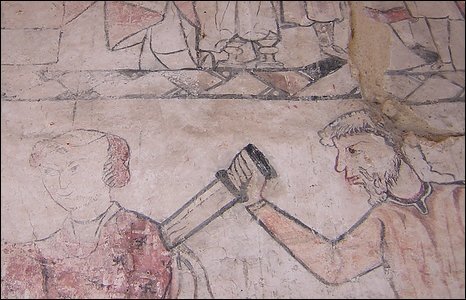 1 Title Slide
1 Title Slide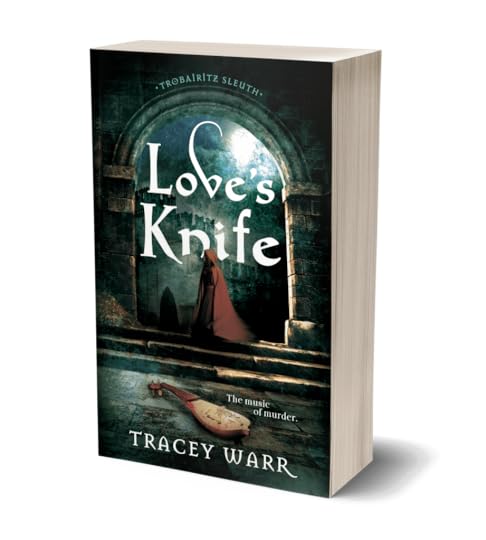 2 Love’s Knife
2 Love’s Knife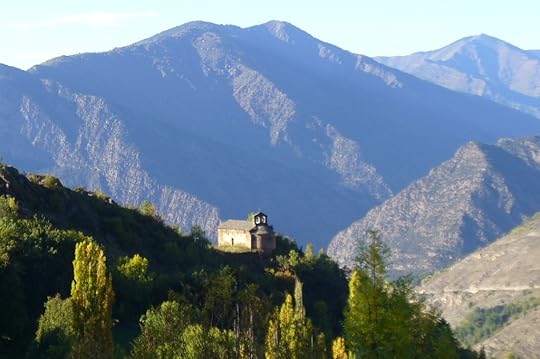 3 Alendo, Catalan Pyrenees
3 Alendo, Catalan Pyrenees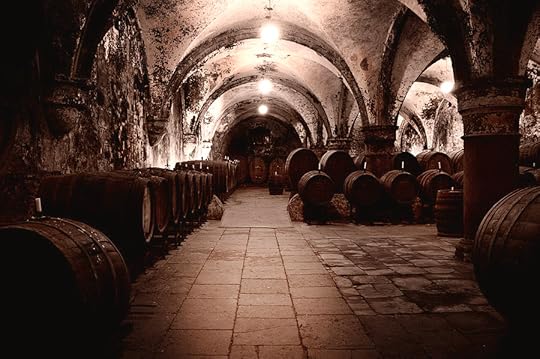 4 Medieval Wine Cellar
4 Medieval Wine Cellar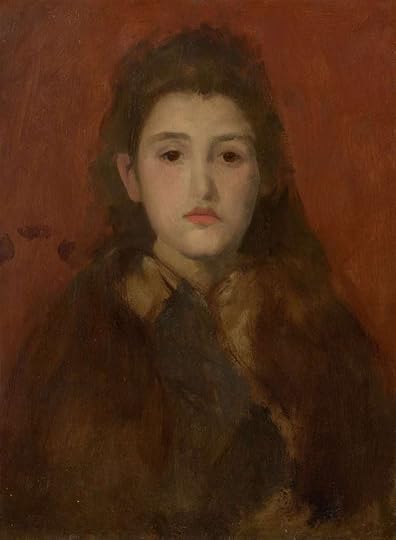 5 Alice Butt by Whistler
5 Alice Butt by Whistler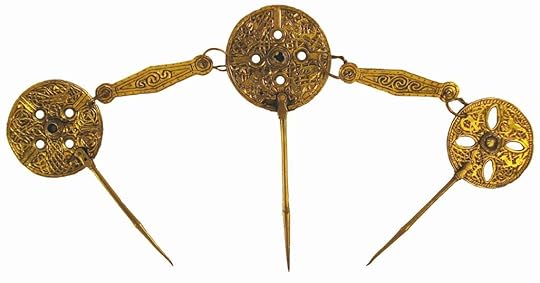 6 Witham Pin, British Museum
6 Witham Pin, British Museum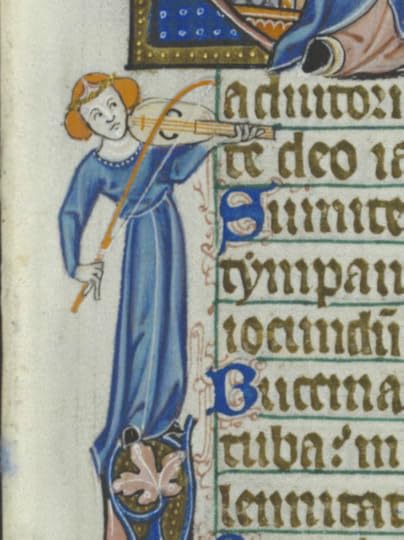 7 Female Vielle Player, Peterborough Psalter
7 Female Vielle Player, Peterborough Psalter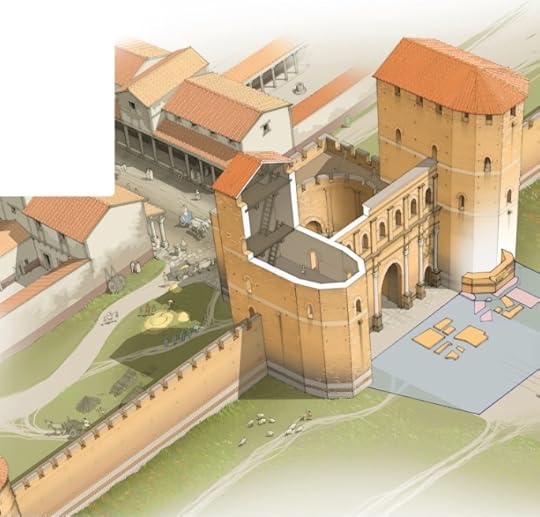 8 Speculative recreation of the early medieval Chateau Narbonnais, the palace of the counts of Toulouse, built into the Roman wall, around one of the gates to the city. Image: Studio Differemmente.
8 Speculative recreation of the early medieval Chateau Narbonnais, the palace of the counts of Toulouse, built into the Roman wall, around one of the gates to the city. Image: Studio Differemmente.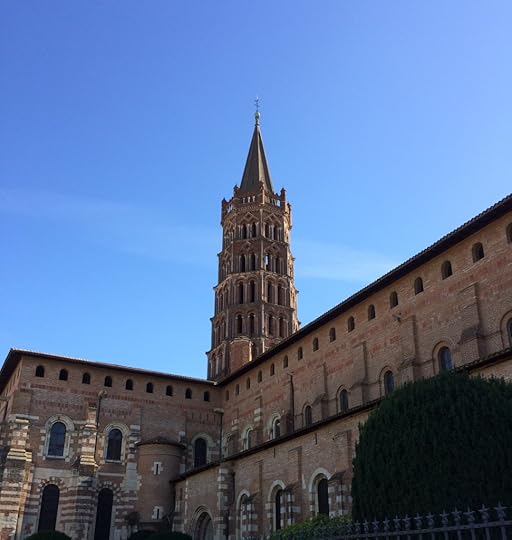 9 Saint-Sernin, Toulouse
9 Saint-Sernin, Toulouse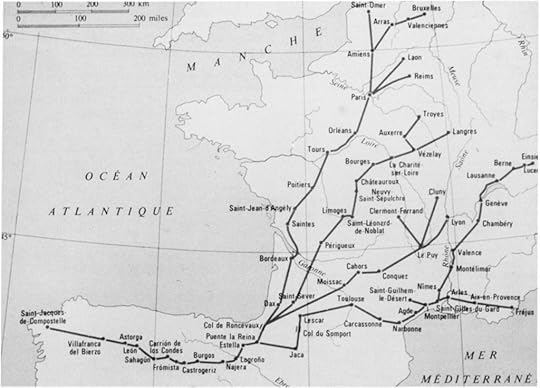 10 The Pilgrim Routes to Santiago de Compostela
10 The Pilgrim Routes to Santiago de Compostela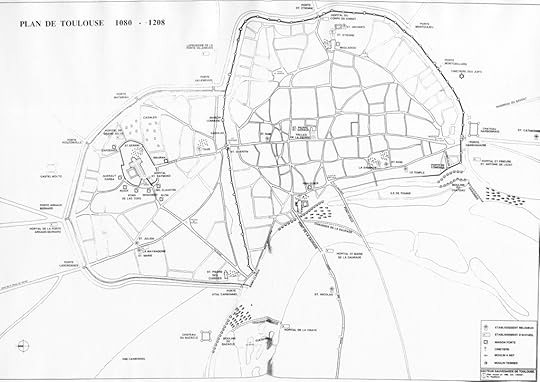 11 Medieval Map of Toulouse, showing floating mills. Musee des Augustins.
11 Medieval Map of Toulouse, showing floating mills. Musee des Augustins.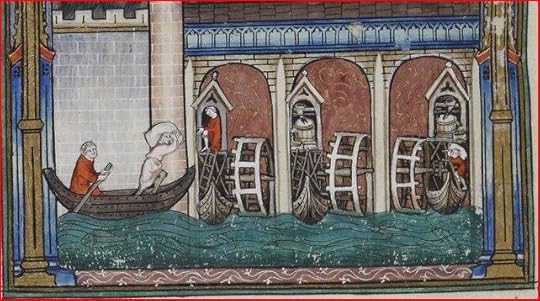 12 Floating mills under a bridge in Paris
12 Floating mills under a bridge in Paris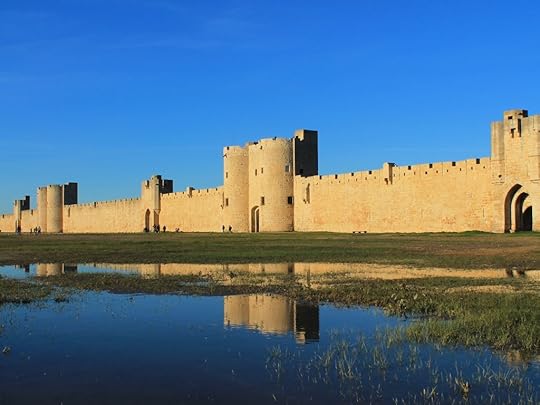 13 Aigues Mortes
13 Aigues Mortes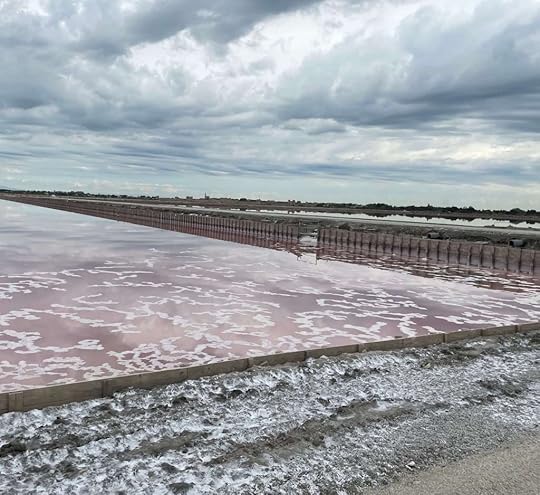 12 Salt Crystals forming, Aigues Mortes
12 Salt Crystals forming, Aigues Mortes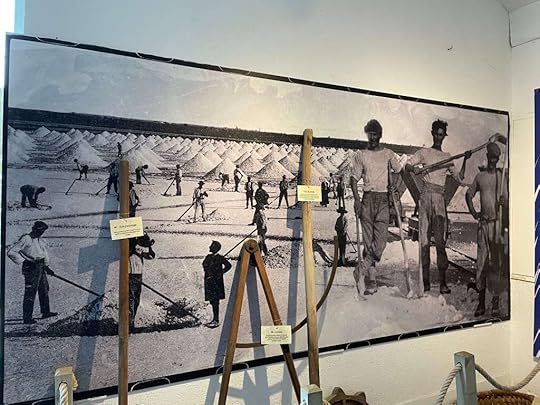 13 Salt Workers Tools, Salt Mounds, Aigues Mortes Salt Museum
13 Salt Workers Tools, Salt Mounds, Aigues Mortes Salt Museum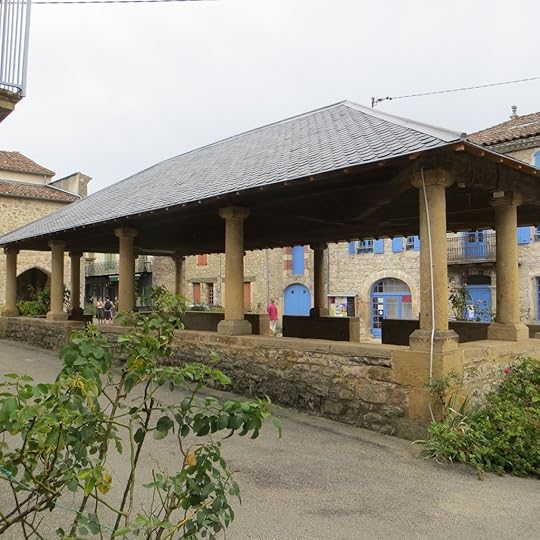 16 Medieval Covered Market at Verfeuil
16 Medieval Covered Market at Verfeuil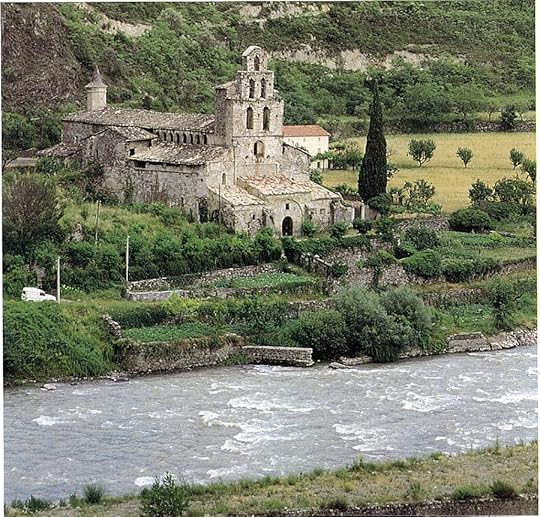 17 Santa-Maria-de-Gerri-de-Sal, Catalan Pyrenees
17 Santa-Maria-de-Gerri-de-Sal, Catalan PyreneesI launched my novel, Love’s Knife, in France last weekend and promised to post the slideshow. Here it is. Images are numbered to coincide with the images in the text of my talk.
Tracey Warr, Writing Medieval Murder
at Library Lit, Parisot Library, 82160 France
Saturday 16 November 2024
[1 title slide]
Love’s Knife [2 slide] has been a long time in the brewing, partly because I was switching from one genre – biographical historical fiction – to another – historical murder mystery, and partly because I had a long writer’s block after the bankruptcy of my original publisher during the COVID lockdowns.
My five previous novels were based on real women I found in medieval chronicles – a trilogy set in Wales and two related but standalone novels set in southern France and Catalonia. I reissued these five books last year with new covers and under my own imprint, Meanda Books.
[3 slide] I first had an idea about the lead character in Love’s Knife, Beatriz the trobairitz (a female troubadour), 10 years ago when I was on a writing residency in Farrera, a village in the Catalan Pyrenees. The chapel across the valley in Alendo was the view from my writing desk. In the end, I didn’t set the first book in this series in the Pyrenees. It just became Beatriz’s backstory, but she will be going there in Book 2, which I’m writing now.
Love’s Knife is mostly set in Toulouse at the end of the 11th century, apart from a few months and chapters when Beatriz goes on the road in the second part of the novel to try to track down the reasons behind the murder. She visits the court of Duke Guillaume IX of Aquitaine in Poitiers. Then she visits the pilgrim abbey of Conques, the town of Uzes where the murder victim had a house, and Aigues Mortes, one of the centres of the lucrative salt trade. Eventually, she returns to Toulouse for the trial of the murderer. Beatriz’s patron and friend is Lady Philippa of Toulouse, the count’s only surviving child and the heiress to the city and county. Beatriz and Philippa are friends with a third young woman, Anna, who has been Philippa’s maid since childhood and who is deaf. My grandfather was deaf and was a great inspiration to me as a reader and writer. I wanted to write a deaf character who would be a contrast to Beatriz’s focus on music and sound. Whilst Beatriz and Anna are my inventions, Philippa of Toulouse and many of the people in the Toulouse court are based on real historical people. I won’t say more about the plot to avoid spoilers. The murder takes place at the beginning of the novel in the castle’s wine cellar [4 slide].
Now that I’m starting to write book 2, I’ve been thinking about how one gets from a wordcount of 0 to a wordcount of 90,000, how one goes from a blank sheet of paper to a manuscript, a story peopled by imagined characters and events. I draw a lot on images, old maps and museum objects when I’m writing.
The nothing to story for me seems to occur through collecting various elements in a research process, then those elements start to coalesce and resonate for me.
[5 slide] I began with the face of Beatriz – which I based on this portrait of a street girl by Whistler and with the murder weapon [6 slide] – this triple pin brooch, which is in the British Museum. Then other things began to attach themselves to that inspirational core and become part of the story.
Beatriz is a jograresa to the trobador Imbert at the court of Toulouse. A jograresa was a performer – a dancer and singer. But Imbert has taught Beatriz to play instruments and she has learnt the complex art of composing troubadour lyrics and aspires to be recognised as a trobairitz. There were real female troubadours. There are around 21 named trobairitz with poems preserved in the manuscripts. That compares to some 400 named male troubadours. Between 26 and 46 songs have been attributed to women.
[7 slide] I had to give Beatriz a main instrument and decided on the vielle – an early version of the violin.
[8 slide] I came across speculative recreations of Chateau Narbonnais, the medieval palace of the counts of Toulouse, which were very important for imagining the spaces Beatriz was moving around in.
[9 slide] Saint-Sernin in Toulouse was being built in 1093 when the novel takes place. It was one of the main pilgrim centres on the route to Santiago de Compostela and is significant to the story.
[10 slide] Beatriz goes to Saint-Sernin and then to Conques to find out about the conflicts going on over the pilgrim routes, which were moneyspinners. The powerful monastery of Cluny was in competition with the pope over control of some of the routes. Beatriz is trying to find out if this was the motive for the murder.
Beatriz’s on-and-off lover Lluis is a sculptor working at Saint-Sernin. His drawing skills become important in Beatriz’s sleuthing. He sketches the crime scene and the body for her to study. Part of my research for the novel was attending a seminar on why people kill presented by a former London homicide detective, Steve Keogh. Obviously what was available to a medieval sleuth differed, but I tried to think about the medieval equivalents of crime scene photos, forensics and murder books. Keogh’s analysis of murder motives and psychology were very important for me in developing my characters and the unfolding of the story.
[11 slide] Another element in my research that fascinated me were the floating flour mills on the Garonne depicted on the medieval map. I found out more about these mills and used them in a chase scene. Floating mills were invented in Rome around 537 AD. [12 slide] In Paris, they operated under bridges, but they could also operate in open water. The count of Toulouse owned the mills near Château Narbonnais. Count Raymond V is recorded granting residents of the city the right to install twenty-four mills and build a causeway near Château-Narbonnais in 1183, so their appearance in my novel is a little anachronistic. The chateau mills were initially naves, boats moored to the banks and equipped with paddle wheels to drive the millstones. During floods, they could be towed to safety. Their proliferation tended to hamper trade on the Garonne. In 1192, the count ordered that the mills be changed to burrows, which were built on stilts. The wheels were probably horizontal. A flood in 1346 destroyed all the Château Narbonnais mills. In later centuries, the mills were also used for fulling, for sawmills and for paper milling. Most medieval mills were owned by the feudal lord and peasants paid a fee to the miller to grind their grain, which the miller collected on behalf of the lord. However, in Toulouse, the counts leased the mill sites to entrepreneurs to build and run. By the twelfth century, the mills were owned by co-proprietors with shares in the investment and profits.
Guillaume of Aquitaine’s poetry and personality were also important for my story. He later becomes the husband of the real historical character of Philippa of Toulouse. He appears in two chapters in this novel and will reappear in later books in the series.
[13 slide] Thinking about motives for the murder, I was very interested in the salt trade, which was so important in the Middle Ages and I visited the salt lakes at the walled city of Aigues Mortes. This is an extraordinary pink, purple, white, blue landscape in the Camargue with flamingoes and white horses. [14 slide, 15 slide] Obviously this photo is not medieval! but some of the tools and methods used by the salt workers would not have changed significantly.
I was interested too in the medieval covered market places, such as this one in Verfeuil. [16 slide] In particular, I was interested in the grain and salt measures that were built into the walls of some of the markets.
In addition to building the characters of Beatriz, Anna, and Philippa and others at the Toulouse court, including Philippa’s uncle Count Raimon of Saint Gilles; her cousin, Bertrand; and Abbot Frotard the papal legate, (all real people), two minor characters, Roger and Mafalda, took on a life of their own and insisted on becoming more than minor characters.
[17 slide] In the next book, Beatriz and many of the other characters travel into the Pyrenees. The salt trade is important again in relation to the monastery of Santa Maria de Gerri and the village of Gerri de Sal, with its salt ponds. The pilgrim routes to Compostela are important again and I’m also drawing on my visit to Sant Pere del Burgul 10 years ago and this fresco of Lucia de la Marca, countess of Pallars Sobira, who was the great-aunt of Philippa of Toulouse. These medieval grave markers are from a village called Tirveu, near my writing residency in Farrera and are for a bellmaker, a blacksmith and a houndsman.
If you’d like to know more about my fiction and research you can sign up for my free quarterly newsletter, Just Meandering, and for my occasional research posts Trobairitz Sleuth.
November 13, 2024
Writing: From 0 to 90,000 words
I am launching my new novel at Parisot Library in France this Saturday, 16 November 10.30am (in case you are in the vicinity).
I will be talking about my various strategies for getting from 0 to 90,000 words, which, in the case of this novel involved salt lakes in the Camargue, chapels in the Pyrenees, pilgrim routes through southern France, medieval markets and wine cellars, floating mills, museum objects and portrait paintings. I will post the full slide show and text of the talk next week.
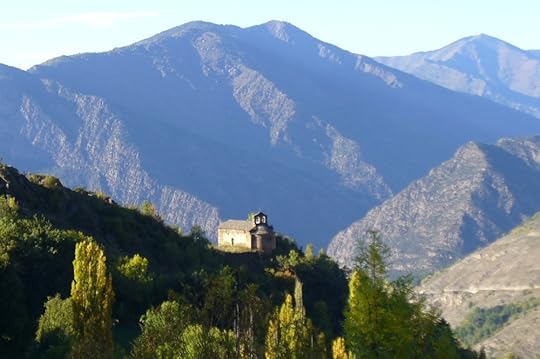


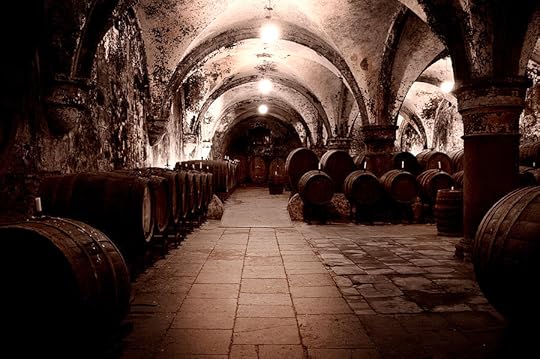
October 26, 2024
Competition for Book Reviewers
Many of us don’t get around to posting reviews of the books we’ve enjoyed. It takes a bit of time to craft a well-worded review, but we writers are very grateful for the ones we do receive and even those with critiques can be very helpful for us. As a book reviewer myself (mostly for Historical Novels Review magazine), I know it takes creative effort to say something fair, eloquent and original about a book you have read.
I’ve received some wonderfully worded reviews over the years for my historical fiction. One of my favourites was for my first novel, Almodis the Peaceweaver:
‘Dear Tracey Warr, I would like to complain: I started reading your novel in the bath and hours later realised that I’d read a third of the novel, was still in the bath, and I was freezing cold.’
I’m running a competition now for the most creative review. Show me what you’ve got!

If you have read my new novel, Love’s Knife, or any of my historical fiction books – see https://meandabooks.com – post your review on Amazon, Goodreads, or both between 26 October and 31 December 2024.
After you have posted, send the link for your review and your email address to info@meandabooks.com.
The five most eloquent reviews (in my opinion) will win my thanks! and a special extra scene, a short story about Beatriz the trobairitz, the protagonist of my murder mystery series. The results will be announced in the January issue of my quarterly newsletter, Just Meandering. (If you haven’t yet signed up for my newsletter, you can do so here.)
Here are a selection of some of the other most eloquent reviews I’ve received in the past:
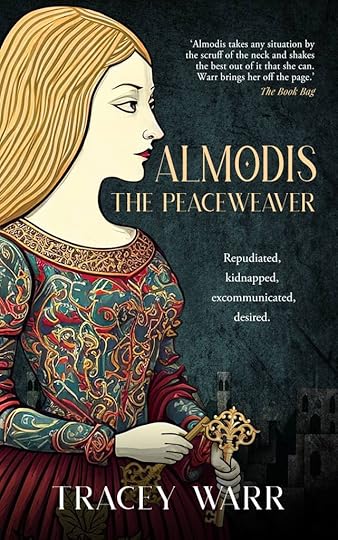
‘Almodis is feisty. She takes any situation by the scruff of the neck and shakes the best out of it that she can. Warr brings her off the page … I read the book over a couple of days when I really should have been doing something else.’ The Book Bag
‘Human chess played with lives and land … Three instantly likeable women fight the system from within.’ The Book Bag
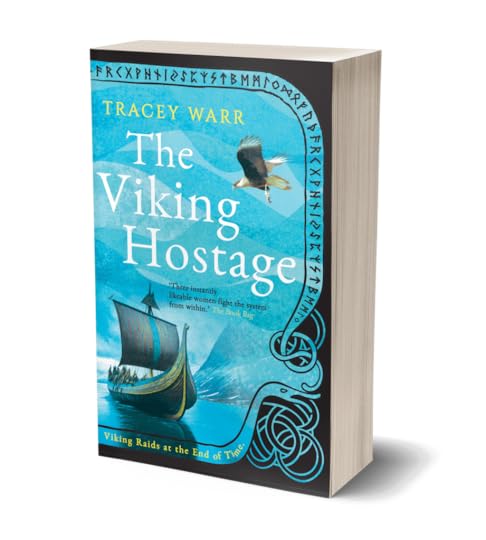
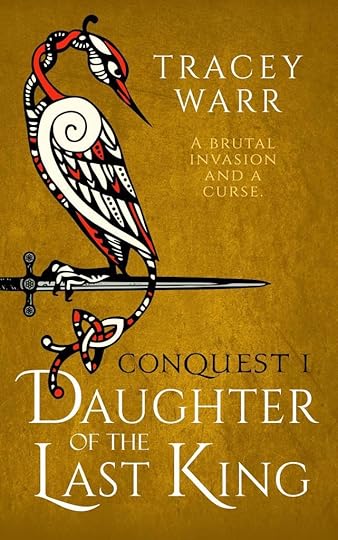
‘As the drawbridge came down and I ventured in, I was not disappointed. In fact I remember nothing of what happened in my every day life until I came out at the end. The level of detail and care and attention which has gone into this novel is spellbinding but it never gets in the way of the plot. A brilliantly woven tapestry of historical intrigue where I felt as if I’d been part of the novel, and part of Nest’s life and I missed her for a while afterwards.’ The Booktrail
‘I could not put this book down from the moment I started it. I practically inhaled the content.’ Poppy Coburn
‘Tracey Warr’s Conquest trilogy spins a most excellent yarn. Although the main character is the hostaged Welsh princess Nest, this is definitely not mediaeval chick lit. The aristocrats are land-grabbing gangsters who plot, kill, maim and poison their way to the thrones. Although her writing has been supported by the the Welsh Arts Council, it’s not all noble Welsh kings being terrorised by the dastardly Normans. The Welsh don’t come off lightly in the plotting, raping and maiming stakes. Read and enjoy, but don’t forget Tracey Warr’s other historical novels. I particularly recommend The Viking Hostage, one of her best.’ Rob La Frenais, Barnes and Noble
‘This is a beautifully written story, set against impressively researched history and narrated at a thriller pace. This is history brought to life with real characters, real events and a great story. I couldn’t put it down and greatly anticipate the second volume.’ Gina Connolly, Goodreads
‘How did I miss this trilogy first time around? It’s hardly my standard fare such as Bernard Cornwell’s Uhtred but to me it was a breath of fresh air. Thought the presentation of the Norman era was splendid. While our heroine and other ladies have a tough old time of it, that was how it was and that is how it is handled. Great.’ S. Morris, Amazon
‘I loved Daughter of the Last King. First off, I loved the cover. This made me want to read the book. I read a lot of historical fiction, and this is about events and an era I have almost zero knowledge of so this appealed to me as well. I had a great time reading this book. The book is narrated by Nest. I felt connected to her, and you really get to know her across the course of the book as she tries to make the best with the circumstances she is forced into. She reminds me a lot of Sansa Stark and what she has to endure in Game of Thrones when her father is killed, and she’s forced to stay with Cersei Lannister. She’s a great character, feisty and brave but she knows her place and how not to aggravate the hand that feeds her. I loved the historical detail as well. The book is rich and vivid in detail. I was engrossed.’ Pamela
‘Highly recommend. Fabulous story woven into Princess Nest’s true life. I have read only some information on the 1100s but this book brought it alive for me. So much ordinary information that readers would love to know. All believable. I found it an exciting read and highly recommend this book to anyone who loves a good novel and loads of history.’ Suzi Hawkins, Amazon
‘Historical fiction at its very best. I loved reading this book because it wasn’t just a series of historical events – it was rich in sensory detail, full of emotion and there was plenty of multi-layered conflict. A roller-coaster ride through sadness, happiness, envy and trepidation. Warr has made an alluring female character from a historical name.’ Harriet Springbett, Goodreads
‘A richly detailed, historical story of life, love, and power in the 11th Century Anglo-Norman kingdom. Not a historical romance but a harsh, realistic, factually-based historical story that will grip you from start to finish. I became hooked by the workings of power, the betrayals and lies, and the treatment of women in the King’s court, and the author really lets you step back into the past to a much harsher time. With plenty of danger, subterfuge, and shocking revelations, Daughter of the Last King is an outstanding piece of historical fiction.’ Books of All Kinds
‘This is a wonderfully written historical novel, full of details that bring to life the people and the England and Wales of the time. From the descriptions of the wild Welsh coast, to the splendid court of Henry I, Tracey Warr makes you feel you are there alongside Nest, experiencing all of the sights and sounds of the medieval world. Highly recommended.’ Christine Rolls, Goodreads
I’m looking forward to reading your new reviews!
October 16, 2024
Starting to write: Old and new beginnings
8 October 2024
My new novel, Love’s Knife, a medieval murder mystery, was published last month. I started writing it 10 years ago during a month-long writing residency in the Pyrenees. It’s been a long time brewing. I just came across a series of blogposts from those weeks of having the initial idea for the novel and am reposting them below.
Now, I am starting again – to write book 2 in the series. Back in 2014, I thought the series would begin in Farrera but after many rewrites, Love’s Knife begins in Toulouse in 1093, when Beatriz de Farrera, my trobairitz sleuth, is 17 years old.
Beatriz and her friends, the deaf maid Anna and Lady Philippa who is the dispossessed heiress of Toulouse, are travelling into the Pyrenees in book 2. No doubt I will use some of the details from my posts below to help me get started with writing the new book.
Love’s Knife ebook or paperback available here: https://www.amazon.co.uk/Loves-Knife-Trobairitz-Sleuth-Book-ebook/dp/B0D1YK2C8G
Cover image shows the view from my writing desk window of the 12th-century chapel of Santa Eulalia in Alendo, on the opposite side of the valley from Farrera.
In Farrera at 1,365 metres above sea level14 October 2014
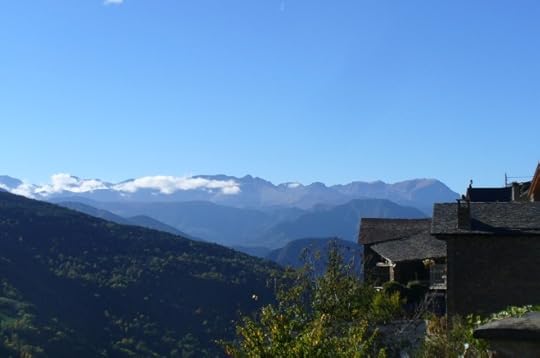
Yesterday I said a temporary goodbye to the river Viaur, swollen by the night’s heavy rain and hailstones, and to the heron who is on the weir every morning outside my tiny house in southern France.
My friend Rob drove me six hours, past Gaillac and Toulouse to the Pyrenees, along the steep sides of deep valleys with a silver ribbon of river below, past ski resorts, and over the Spanish border to the tiny village of Farrera, 1,365m above sea level, in the ancient county of Pallars Sobira in the Catalan Pyrenees. In the darkness we couldn’t see the mountains around us but sensed them as the road wound steeply up and up and round and round on itself.
We arrived to a welcome from the director of the Centre d’Art i Natura, Lluis Llobet. I am spending three weeks here as writer in residence. We sat down for the evening meal with the other artists in residence: Quelic Berga from Barcelona, Tuula Närhinen from Helsinki and Anna Rubio, who lives in Farrera.
Woke to see what a beautiful place I have arrived in. Organised my desk and walked around the valley to the nearby village of Alendo. Belled sheep are jumping along the ridge sounding like a Balinese Gamelan. Two black mules graze in the valley. A tired grasshopper sits on the path. Dark mountain peaks stand proud of brilliant white wisps of cloud in a blue dream of sky. I am fascinated by the drystone wall constructions. The houses have stones jutting out to sit on, rest your basket on, or for the postman to leave a parcel, or there are cubby-holes in the walls for post or lamps or bottles of milk. There is nothing extraneous. These useful extrusions and intrusions are integral to the houses. The rose window of the old church is created with what looks like a cartwheel. Grey and brown slate roofs are like fish scales. Tall, thin poplars in the valley are growing densely and looking like a green sea, waving. The tree-clad mountainside opposite has the occasional autumnal splash, tree tips dipped in intense red.
I am planning to start writing a novel here that I am calling A Morsel of Love’s Bread, and its Knife, which is adapted from a line of poetry by the Troubadour Duke, Guillaume IX of Aquitaine, written in the 11th century. Guillaume’s poetry is a paradox: half of his surviving works are very raunchy and the other half are heartfelt lyrical love songs. He will be one of the characters in my novel.
At dinner we talk about the origins of the Centre d’Art i Natura which opened in 1996. The Pyrenean villages were steadily depopulating during the 20th century. By the 1970s many where empty and abandoned and Farrera itself had only a handful of mostly aging residents. After Franco’s death in 1975 some of the young people from Barcelona and elsewhere started to move out of the cities, seeking a new rural lifestyle living on the land, as they were also doing in the UK, migrating to villages in rural Wales, Cumbria, Northumberland and the Scottish Highlands. Lluis and his wife Ceske were amongst those who moved to Farrera and there were also new inhabitants from Ireland, Bernard Loughlin and his wife Mary, and occasionally their friend Colm Tóibín whose novel The South, is set in Farrera. I’ve borrowed it from the library here to read.
Writing Eyrie16 October 2014
 Dag Peterson’s watercolour of the Cockerel on Farrera’s Bell Tower
Dag Peterson’s watercolour of the Cockerel on Farrera’s Bell TowerTuula Narhinen, Quelic Berga and I spent the first few days here in Casa Ramon and I grew quite fond of my attic writing eyrie but tomorrow we are moving into the newer, purpose built rooms in the Centre which face out across the spectacular view of the valley and mountains. The skylight in my attic room in Casa Ramon has a view straight to the weather vane and bell tower of the church. Quelic is working on an installation combining notions of Google and God. Tuula is flying a camera with a kite but is having trouble finding enough wind or, when there is wind, controlling it in the unpredictable turbulence around the mountains. Every day she climbs to Coll de So, the Pass of Sound, seeking wind and has met with plenty of cows. She is painting the colours of Farrera. I am looking forward to finding out more about their work.
At dinner Lluis and Quelic talk about Catalan independence and history. There has been iron mining in this area for centuries and hence the name of this village. Each night Arnau Llobet cooks an amazing meal for us and his artistry extends beyond the delicious food too. Tonight he has scattered pomegranates and red autumn leaves on the table so that it is like picknicking in a forest glade. He was up early climbing above 2000 feet to gather the mushrooms that make part of our meal this evening. He tells us about seeing the shy chamois deer up there.
The future and the past17 October 2014
I am working on two new novels. One is set in the late 11th century and features a female troubadour from this village, Farrera. Most of the action takes place in Toulouse and Poitiers, but there will also be some scenes set here and in Aragon.
The second new novel I am working on is set in the future, in the 23rd century, and engages with climate change and accompanying change on all levels: social, economic, technological. I am especially interested in what the old technologies, lifestyles and means of survival from the past can teach us about the future. At dinner I talk with Ceske about the food that she and Arnau and many Catalans are used to foraging from their environments: mushrooms, fruit, nuts, herbs, and how many city people in the UK and probably many rural ones too no longer have this knowledge for living with the seasonal rhythms.
Fishing in the Library18 October 2014
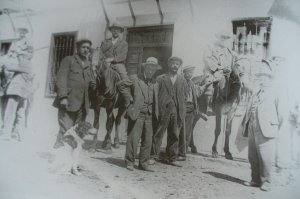 The Prince of Monaco and retainers on a trout fishing expedition in the Pyrenees in 1918
The Prince of Monaco and retainers on a trout fishing expedition in the Pyrenees in 1918A fabulous day in the library reading about Farrera – birds and wildlife, plants and landscape, people. I read about barking deer, boars with their striped piglets, wild cats and tufty eared red squirrels, fields of white Narcissus Poeticus, Tengleman’s Owl, Black Woodpeckers, the Capercaillie and the Lammergeir or Bearded Vulture. I feel like I have arrived now with a better sense of where I am. A smoky sunset on the mountain peaks.
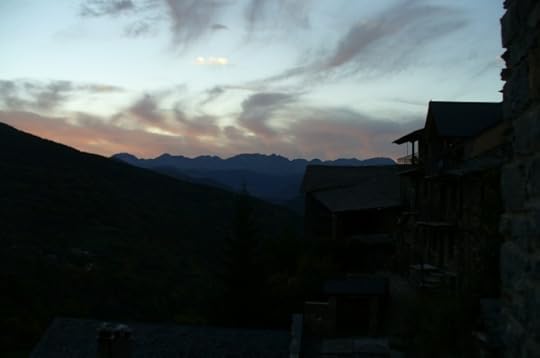 Romanesque
Romanesque1 November 2014
 Sant Pere del Burgal frescos in MNAC, Barcelona
Sant Pere del Burgal frescos in MNAC, Barcelona
 Llucia de la Marca
Llucia de la MarcaWent to Sant Pere del Burgal near Escalo in the Pyrenees a few days ago to see the 11th century frescos in the church by the Master of Pedret.
Below the Holy Family and the saints, Llucia de la Marca is represented. She was the Countess of Pallars Sobira and the sister of the heroine of my first novel, Almodis the Peaceweaver. The originals have been removed for safekeeping to MNAC Museum in Barcelona and the church has very good reproductions in their place. It was good to imagine them in situ and to see the situation of the monastery.
Also visited medieval tombstones in Tirvia which show the deceased persons’ occupations.
 Headstone for a houndsman, Tirvia
Headstone for a houndsman, Tirvia
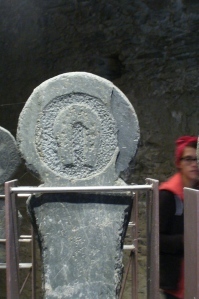 Headstone for a Smith, Tirvia
Headstone for a Smith, Tirvia
 Headstone for a Bellmaker, TirviaThe little river tributaries number more than your eyelashes
Headstone for a Bellmaker, TirviaThe little river tributaries number more than your eyelashesAlso found in the Farrera library.
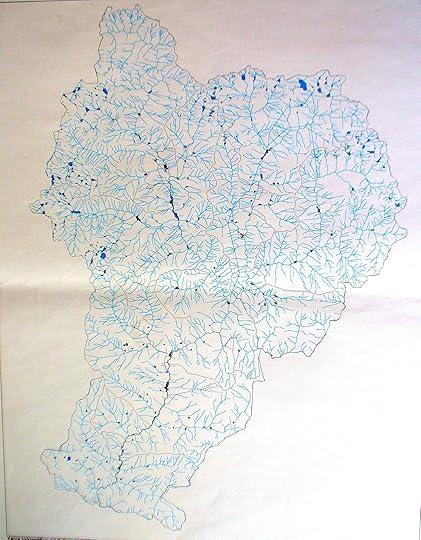 Hydra Map of Pallars Sobira in the Catalan Pyrenees
Hydra Map of Pallars Sobira in the Catalan Pyrenees[The post title is adapted from a poem by Keats.]
October 10, 2024
Time-Sensitive Historical Fiction
Today is the last day that you can buy my new novel, Love’s Knife, as an ebook on amazon.co.uk for a mere £0.99. The price goes back to its normal £4.99 in 17 hours or so. It’s also available as a paperback.
Love’s Knife is a medieval murder mystery set in Toulouse at the turn of the 12th century, featuring a trobairitz sleuth – a female troubadour solving murders.
Did you know that sleuth – meaning tracker – is a Viking and Middle English word?
This novel is book 1 in a new series. My trobairitz heroine, Beatriz de Farrera, finds herself encountering as many murders as Inspector Barnaby in Midsomer Murders. In book 2, which I’m writing at the moment. Beatriz travels into the Pyrenees and the Iberian kingdoms with her deaf friend Anna and her patron Lady Philippa of Toulouse.
October 7, 2024
On a Viking trouser-snake
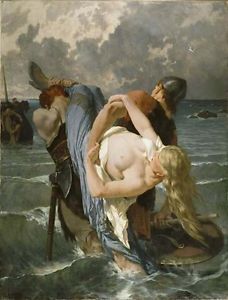
I’ve a crick in my neck,
And tend to fall on my head,
My trouser-snake is soft,
And my hearing’s gone away.
The extract above is from Judith Jesch’s translation of a lament on old age by the 10th century Viking skald (or poet) Egil Skallagrimsson.
The image is a 19th century French painting by Evariste Vital Luminais. The first publisher of my novel, The Viking Hostage, suggested using this painting on the book’s cover, which I roundly rejected, as I am trying to break stereotypes of Vikings in the novel.
The Viking Hostage imagines a viking settlement on an island off the coast at Tenby in Wales. (There were real Viking settlements on the Welsh islands and my fictional island is a blend of Caldey and Skomer.) I was talking a while back with a TV researcher about why contemporary people from the Welsh coast, might like the idea of having Viking DNA, despite the popular image of Vikings as brutal raiders and slavers (which indeed they were). Nevertheless, we can’t help but be impressed by the adventurous spirit of the Vikings and their achievements as seaborne explorers.
I’m intrigued by the way that Vikings might have seen the map of the world, inside out as it were, from the perspective of the oceans and rivers that were their roads. One of their ‘roads’ skirted through the Scottish islands and came down past the Isle of Man, threaded between Ireland and Wales, and moved on towards France.
I tried to write about Vikings as fully rounded people, rather than two-dimensional villains, as tender and funny, as well as fearsome pagan warriors. 8th to 11th century Scandinavia (the Viking Age) was a rich and complex culture as the British Museum’s 2014 exhibition, Vikings, demonstrated.
There is evidence that Viking women were on some of the ships and evidence that some of them were warriors. Stories of the red maiden, a red-haired female warrior, on the ships off the Welsh coast, were among the inspirations for my novel. Vikings were also traders, farmers and mercenaries, integrating with the other cultures they encountered.
Evidence about the Vikings in Wales is in place names especially islands and coastal ports; in the Icelandic Sagas; in recent archaeological evidence, for instance at Anglesey; and in the Welsh Annals written at St David’s Cathedral where they had good cause to moan about them since Vikings raided the cathedral eleven times.
See Judith Jesch’s Viking Poetry of Love and War (2013) published by the British Museum; Mark Redknap, Vikings in Wales: An Archaeological Quest (2000); Gareth Williams and Peter Pentz’s Vikings: Life and Legends (2014); and the Vikings television drama series.
France was another place where there was good reason to think of Vikings with less than fondness. My novel, The Viking Hostage, set in France and Wales, is published by Meanda Books.
BUY THE BOOK
October 5, 2024
Parisot Literary Festival 2024
When I moved to a village in southwest France some sixteen years ago, I thought I would find myself in splendid isolation, with no distractions from writing, but I quickly acquired a writers’ group, then a reading group, and discovered that I was living in proximity to a big literary festival in a small French village. Festilitt, the Parisot Literary Festival, is a bilingual event that has featured Kate Mosse, Tessa Hadley, Sarah Winman, Helen Dunmore and many more. I appeared in that festival ten years ago, and have reposted my blog from that year below.
It’s that time of year again now – mid-October – and the festival is coming next weekend (Parisot 82160). This year’s edition includes Sunjeev Sahota, Jean Poderos, Leonor de Rocondo, Nicolas Padamsee, and M.L. Longworth. The second-hand booksale (English and French) is always a highlight too for additions to my teetering to-be-read pile.
And next month, I will be talking in Parisot’s Library Lit series, on my new novel, Love’s Knife. Sat 16 November 10.30am.
Thunder and Lightning at the Parisot Literary Festival, 2014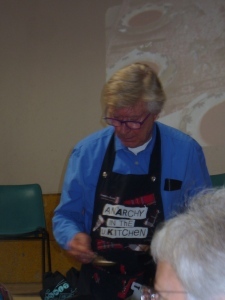
Robin Ellis giving a cooking demonstration in Sex Pistols apron
The Parisot Literary Festival is an extraordinary annual event in Southern France. Over 80 people came this year to the tiny, ancient village of Parisot to listen to three days of inspiring presentations and workshops by French and English writers.
Amongst the English presenters: Vanessa Couchman spoke about her novel The House at Zaronza (Crooked Cat) which is set on Corsica, and Amanda Hodgkinson talked about the stresses and joys of producing her second novel, Spilt Milk (Penguin). Non-fiction writers Piu Marie Eatwell and Clive Ponting gave fascinating presentations on myths about the French (Eatwell) and myths about the First World War (Ponting).
On Sunday morning we were treated to a cookery demonstration for diabetics (and everyone else) by Robin Ellis who is most well-known for his acting role in the hugely popular 1970s TV series Poldark. We tasted pumpkin soup and salmon fishcakes as Robin chatted to us about his acting career, wearing a Sex Pistols apron.
I was one of the last speakers in the festival and talked about researching and writing my historical novels Almodis and The Viking Hostage (Meanda Books).
All the authors were billeted on local families for the duration of the festival and talks were punctuated with informal social occasions. There was lots of time for discussions about writing over dinner and some very good cakes.
I will definitely be at this brilliant festival next year as a punter. The sun shone on us throughout and the skies were azure blue but during an after-the-festival drink, I noticed that the clouds were gathering themselves for some serious action. I got caught in a terrific thunder and lightning storm with giant hailstones and caught in a terrific conversation, as I sheltered, with friends Carlos and Christine, on climate change, permaculture and Timothy Morton’s book Ecology Without Nature.
October 2, 2024
October Newsletter
My quarterly newsletter, Just Meandering, is out now on https://justmeandering.substack.com
It has articles on my new novel, on recent author events, on starting on a new writing project and on a free book offer. Sign up for free to read it.
My latest novel, Love’s Knife is available as an ebook for a mere £0.99 on a Kindle Countdown Deal from 8am 4 October to 8am 11 October.
I will be talking in the Library Lit series at Parisot Library, France on Saturday 16 November 10.30am. More info on that event coming soon.
September 23, 2024
Rock, Paper, Swords! interview
I’m still emerging from the mammoth and thrilling task of organising the HNS UK 2024 conference. It could take a while!
Matthew Harffy and Steven A. McKay interviewed me for their roving podcast from the conference: https://www.youtube.com/watch?v=gh2b63b-efM
Check out their podcast for interviews with the conference speakers including Bernard Cornwell, Diana Gabaldon, Kate Quinn + Alison Morton + Ruth Downie, David Gilman, Elizabeth Chadwick, Ian Mortimer, Michael Jecks, and more.
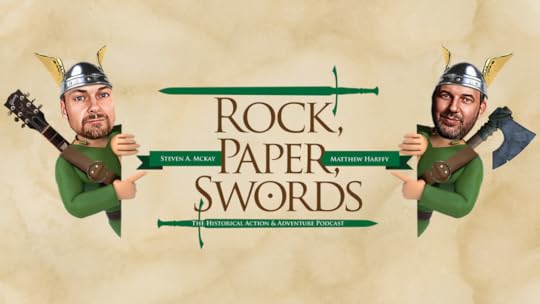
September 10, 2024
Medieval vielle


I have just emerged from organising the Historical Novel Society UK 2024 conference at Dartington Hall in Devon. The conference had 250 delegates onsite and another 150 online. Speakers included Bernard Cornwell, Diana Gabaldon, Ian Mortimer, S.G. MacLean, Elizabeth Chadwick and Kate Quinn.
The chairman of the society, Richard Lee, presented me with this replica medieval vielle – the instrument played by the heroine of my latest novel, Beatriz de Farrera. The instrument features – blood spattered – on the front cover of the novel, which is a medieval murder mystery.
I am absolutely chuffed! What a brilliant gift!
I’ve just been to buy a case to fly home to France, so now I look like a musician. I will have to ask the luthier in my village if he might be able to show me how to play at least one note.
Love’s Knife is just out in paperback and ebook.



